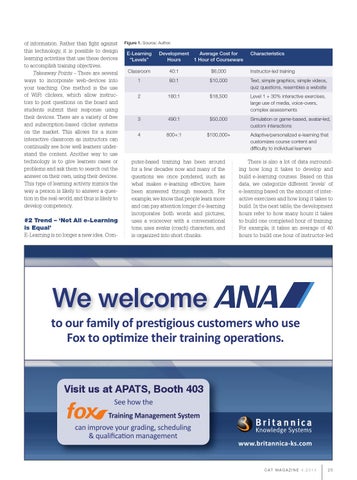of information. Rather than fight against this technology, it is possible to design learning activities that use these devices to accomplish training objectives. Takeaway Points – There are several ways to incorporate web-devices into your teaching. One method is the use of WiFi clickers, which allow instructors to post questions on the board and students submit their response using their devices. There are a variety of free and subscription-based clicker systems on the market. This allows for a more interactive classroom as instructors can continually see how well learners understand the content. Another way to use technology is to give learners cases or problems and ask them to search out the answer on their own, using their devices. This type of learning activity mimics the way a person is likely to answer a question in the real-world, and thus is likely to develop competency.
#2 Trend – ‘Not All e-Learning is Equal’ E-Learning is no longer a new idea. Com-
Figure 1. Source: Author.
E-Learning “Levels” Classroom
Development Average Cost for Hours 1 Hour of Courseware 40:1
$6,000
Characteristics Instructor-led training
1 80:1 $10,000
Text, simple graphics, simple videos, quiz questions, resembles a website
2 180:1 $18,500
Level 1 + 30% interactive exercises, large use of media, voice-overs, complex assessments
3 490:1 $50,000
Simulation or game-based, avatar-led, custom interactions
4 800+:1 $100,000+
Adaptive/personalized e-learning that customizes course content and difficulty to individual learners
puter-based training has been around for a few decades now and many of the questions we once pondered, such as what makes e-learning effective, have been answered through research. For example, we know that people learn more and can pay attention longer if e-learning incorporates both words and pictures, uses a voiceover with a conversational tone, uses avatar (coach) characters, and is organized into short chunks.
There is also a lot of data surrounding how long it takes to develop and build e-learning courses. Based on this data, we categorize different ‘levels’ of e-learning based on the amount of interactive exercises and how long it takes to build. In the next table, the development hours refer to how many hours it takes to build one completed hour of training. For example, it takes an average of 40 hours to build one hour of instructor-led
We welcome to our family of prestigious customers who use Fox to optimize their training operations.
Visit us at APATS, Booth 403 See how the Training Management System can improve your grading, scheduling & qualification management
www.britannica-ks.com
CAT MAGAZINE 4.2014
25
